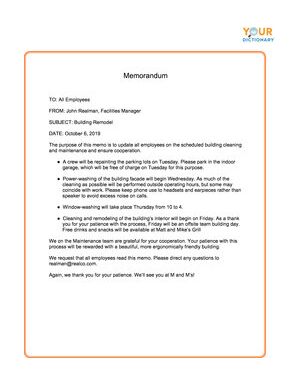

If you work in an office, you likely have to write memorandums. A memorandum, or memo for short, is quite easy to put together. In their most basic form, memorandums are just a short form of a letter. There may be a heading written in bold or italics for emphasis. Additionally, the memo may address a certain issue or request permission to do something from an upper level executive.
Simple Steps for Memo Format
A memo is a written business communication that conveys basic information. Using a simple, straightforward format makes that easy. You should always check whether your workplace has a standard form for memorandums. If not, follow the steps below for a universally acceptable memo format.
- Title: The word "Memorandum" should be in a significantly larger font, bolded and either centered or placed in the top left-hand corner.
- Recipient: Begin this heading with "TO:" and write down your recipient(s).
- Source: Immediately after the recipient, write "FROM:" along with your name and position.
- Subject: Write a short summary of the memo's purpose (no more than about four words).
- Date: Include the date of when the memo is sent.
Keeping to strict styles like this improves clarity and avoids the danger of poor grammar or unclear communication.
Tips for Writing a Memo
Here are a few quick tips for writing effective memorandums:
- Check for stylistic requirements with your job. Does the company have a standard form when it comes to writing memos? If so, is it downloadable?
- Make sure that the body of the text is clear, concise and grammatically correct.
- Keep things simple. Avoid long sentences and wordy phrasing.
- Do not use a salutation. You should simply go right into the subject of the memo.
- Use bulleted lists and headings to convey your message.
- Conclude the memo with any closing statements that may inspire the recipient to take action.
- Mention any and all attachments at the end of the memo by using the single word "Attachment."
- Once you've completed a draft, share it with a colleague. An extra pair of eyes always helps to catch errors and improve readability.
Writing Your Memo
Open with an introductory paragraph in which you introduce the purpose of the memo. You can start your memo with a sentence as simple as "the purpose of this memo is to…" Once you state the purpose, you can move forward to the next section.
The next section of your memo would be to describe the issue surrounding your memo. Next you will want to discuss what you have done to better research the issue surrounding your memo. Include as much basic information as possible. Additionally, if confirmation is needed from the recipient, you will need to make sure that you stipulate that clearly.
To state all relevant information in the shortest space available, take a look at our advice on informative essays. Keep the differences between business writing and academic writing in mind; memos should follow the rules of business writing.
You need not try to squeeze a lot of information into the memo because it is not necessarily a project proposal. The whole purpose of a memo is to make the recipient aware of an issue. If you keep it simple, it will be an easy task.
Example Memorandum
We've provided an example memorandum that follows all our instructions and tips for memo writing. Our sample memo is also available as a downloadable PDF for future reference.
TO: All Employees
FROM: John Realman, Facilities Manager
SUBJECT: Building Remodel
DATE: October 6, 2019
The purpose of this memo is to update all employees on the scheduled building cleaning and maintenance and ensure cooperation.
- A crew will be repainting the parking lots on Tuesday. Please park in the indoor garage, which will be free of charge on Tuesday for this purpose.
- Power-washing of the building facade will begin Wednesday. As much of the cleaning as possible will be performed outside operating hours, but some may coincide with work. Please keep phone use to headsets and earpieces rather than speaker to avoid excess noise on calls. Window-washing will take place Thursday from 10 to 4.
- Cleaning and remodeling of the building's interior will begin on Friday.
- As a thank you for your patience with the process, Friday will be an offsite team building day. Free drinks and snacks will be available at Matt and Mike's Grill
We on the Maintenance team are grateful for your cooperation. Your patience with this process will be rewarded with a beautiful, more ergonomically friendly building.
We request that all employees read this memo. Please direct any questions to realman@realco.com.
Again, we thank you for your patience. We'll see you at M and M's!

Memo Mentality
Memos can be the easiest piece of correspondence that an administrative professional will ever have to write. It is important to just keep formatting standards at the forefront and grammatical errors at a minimum. Always make it a point to edit and proofread your memo prior to sending it out.
For more help with common forms of professional writing, take a look at our types of business communication, as well as our comprehensive guide to writing letters in a business setting!